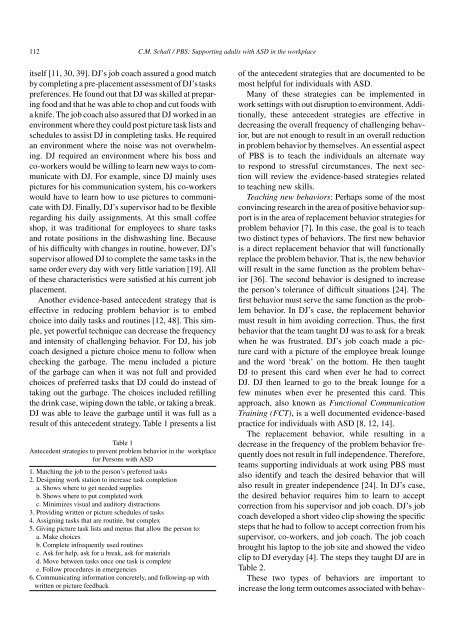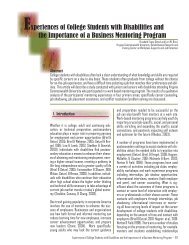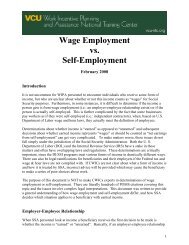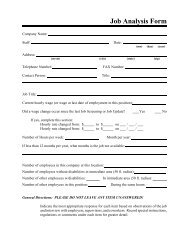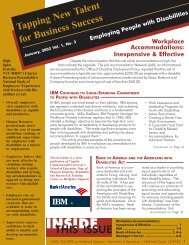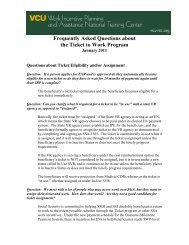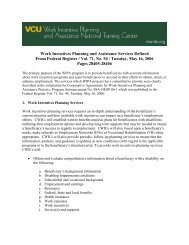Supporting adults with autism spectrum disorders in the ... - IOS Press
Supporting adults with autism spectrum disorders in the ... - IOS Press
Supporting adults with autism spectrum disorders in the ... - IOS Press
You also want an ePaper? Increase the reach of your titles
YUMPU automatically turns print PDFs into web optimized ePapers that Google loves.
112 C.M. Schall / PBS: <strong>Support<strong>in</strong>g</strong> <strong>adults</strong> <strong>with</strong> ASD <strong>in</strong> <strong>the</strong> workplaceitself [11, 30, 39]. DJ’s job coach assured a good matchby complet<strong>in</strong>g a pre-placement assessment of DJ’s taskspreferences. He found out that DJ was skilled at prepar<strong>in</strong>gfood and that he was able to chop and cut foods <strong>with</strong>a knife. The job coach also assured that DJ worked <strong>in</strong> anenvironment where <strong>the</strong>y could post picture task lists andschedules to assist DJ <strong>in</strong> complet<strong>in</strong>g tasks. He requiredan environment where <strong>the</strong> noise was not overwhelm<strong>in</strong>g.DJ required an environment where his boss andco-workers would be will<strong>in</strong>g to learn new ways to communicate<strong>with</strong> DJ. For example, s<strong>in</strong>ce DJ ma<strong>in</strong>ly usespictures for his communication system, his co-workerswould have to learn how to use pictures to communicate<strong>with</strong> DJ. F<strong>in</strong>ally, DJ’s supervisor had to be flexibleregard<strong>in</strong>g his daily assignments. At this small coffeeshop, it was traditional for employees to share tasksand rotate positions <strong>in</strong> <strong>the</strong> dishwash<strong>in</strong>g l<strong>in</strong>e. Becauseof his difficulty <strong>with</strong> changes <strong>in</strong> rout<strong>in</strong>e, however, DJ’ssupervisor allowed DJ to complete <strong>the</strong> same tasks <strong>in</strong> <strong>the</strong>same order every day <strong>with</strong> very little variation [19]. Allof <strong>the</strong>se characteristics were satisfied at his current jobplacement.Ano<strong>the</strong>r evidence-based antecedent strategy that iseffective <strong>in</strong> reduc<strong>in</strong>g problem behavior is to embedchoice <strong>in</strong>to daily tasks and rout<strong>in</strong>es [12, 48]. This simple,yet powerful technique can decrease <strong>the</strong> frequencyand <strong>in</strong>tensity of challeng<strong>in</strong>g behavior. For DJ, his jobcoach designed a picture choice menu to follow whencheck<strong>in</strong>g <strong>the</strong> garbage. The menu <strong>in</strong>cluded a pictureof <strong>the</strong> garbage can when it was not full and providedchoices of preferred tasks that DJ could do <strong>in</strong>stead oftak<strong>in</strong>g out <strong>the</strong> garbage. The choices <strong>in</strong>cluded refill<strong>in</strong>g<strong>the</strong> dr<strong>in</strong>k case, wip<strong>in</strong>g down <strong>the</strong> table, or tak<strong>in</strong>g a break.DJ was able to leave <strong>the</strong> garbage until it was full as aresult of this antecedent strategy. Table 1 presents a listTable 1Antecedent strategies to prevent problem behavior <strong>in</strong> <strong>the</strong> workplacefor Persons <strong>with</strong> ASD1. Match<strong>in</strong>g <strong>the</strong> job to <strong>the</strong> person’s preferred tasks2. Design<strong>in</strong>g work station to <strong>in</strong>crease task completiona. Shows where to get needed suppliesb. Shows where to put completed workc. M<strong>in</strong>imizes visual and auditory distractions3. Provid<strong>in</strong>g written or picture schedules of tasks4. Assign<strong>in</strong>g tasks that are rout<strong>in</strong>e, but complex5. Giv<strong>in</strong>g picture task lists and menus that allow <strong>the</strong> person to:a. Make choicesb. Complete <strong>in</strong>frequently used rout<strong>in</strong>esc. Ask for help, ask for a break, ask for materialsd. Move between tasks once one task is completee. Follow procedures <strong>in</strong> emergencies6. Communicat<strong>in</strong>g <strong>in</strong>formation concretely, and follow<strong>in</strong>g-up <strong>with</strong>written or picture feedbackof <strong>the</strong> antecedent strategies that are documented to bemost helpful for <strong>in</strong>dividuals <strong>with</strong> ASD.Many of <strong>the</strong>se strategies can be implemented <strong>in</strong>work sett<strong>in</strong>gs <strong>with</strong> out disruption to environment. Additionally,<strong>the</strong>se antecedent strategies are effective <strong>in</strong>decreas<strong>in</strong>g <strong>the</strong> overall frequency of challeng<strong>in</strong>g behavior,but are not enough to result <strong>in</strong> an overall reduction<strong>in</strong> problem behavior by <strong>the</strong>mselves. An essential aspectof PBS is to teach <strong>the</strong> <strong>in</strong>dividuals an alternate wayto respond to stressful circumstances. The next sectionwill review <strong>the</strong> evidence-based strategies relatedto teach<strong>in</strong>g new skills.Teach<strong>in</strong>g new behaviors: Perhaps some of <strong>the</strong> mostconv<strong>in</strong>c<strong>in</strong>g research <strong>in</strong> <strong>the</strong> area of positive behavior supportis <strong>in</strong> <strong>the</strong> area of replacement behavior strategies forproblem behavior [7]. In this case, <strong>the</strong> goal is to teachtwo dist<strong>in</strong>ct types of behaviors. The first new behavioris a direct replacement behavior that will functionallyreplace <strong>the</strong> problem behavior. That is, <strong>the</strong> new behaviorwill result <strong>in</strong> <strong>the</strong> same function as <strong>the</strong> problem behavior[36]. The second behavior is designed to <strong>in</strong>crease<strong>the</strong> person’s tolerance of difficult situations [24]. Thefirst behavior must serve <strong>the</strong> same function as <strong>the</strong> problembehavior. In DJ’s case, <strong>the</strong> replacement behaviormust result <strong>in</strong> him avoid<strong>in</strong>g correction. Thus, <strong>the</strong> firstbehavior that <strong>the</strong> team taught DJ was to ask for a breakwhen he was frustrated. DJ’s job coach made a picturecard <strong>with</strong> a picture of <strong>the</strong> employee break loungeand <strong>the</strong> word ‘break’ on <strong>the</strong> bottom. He <strong>the</strong>n taughtDJ to present this card when ever he had to correctDJ. DJ <strong>the</strong>n learned to go to <strong>the</strong> break lounge for afew m<strong>in</strong>utes when ever he presented this card. Thisapproach, also known as Functional CommunicationTra<strong>in</strong><strong>in</strong>g (FCT), is a well documented evidence-basedpractice for <strong>in</strong>dividuals <strong>with</strong> ASD [8, 12, 14].The replacement behavior, while result<strong>in</strong>g <strong>in</strong> adecrease <strong>in</strong> <strong>the</strong> frequency of <strong>the</strong> problem behavior frequentlydoes not result <strong>in</strong> full <strong>in</strong>dependence. Therefore,teams support<strong>in</strong>g <strong>in</strong>dividuals at work us<strong>in</strong>g PBS mustalso identify and teach <strong>the</strong> desired behavior that willalso result <strong>in</strong> greater <strong>in</strong>dependence [24]. In DJ’s case,<strong>the</strong> desired behavior requires him to learn to acceptcorrection from his supervisor and job coach. DJ’s jobcoach developed a short video clip show<strong>in</strong>g <strong>the</strong> specificsteps that he had to follow to accept correction from hissupervisor, co-workers, and job coach. The job coachbrought his laptop to <strong>the</strong> job site and showed <strong>the</strong> videoclip to DJ everyday [4]. The steps <strong>the</strong>y taught DJ are <strong>in</strong>Table 2.These two types of behaviors are important to<strong>in</strong>crease <strong>the</strong> long term outcomes associated <strong>with</strong> behav-


